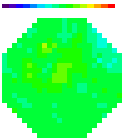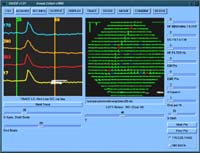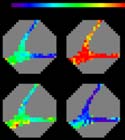|

All content
copyright © 1995-2001
RedShirtImaging, LLC.
Website Design by
Elizabeth Nephew
|
User
Interface | Data Aquisition | Data Analysis
- New Features
- We incorporate approximately 90% of users suggestions about
new features and improvements to the software.
- The Software
- The software consists of 2 distinct sections, Analysis and Acquisition.
The analysis section runs under Windows95 or Unix (we have tested only
Sun Solaris 7).
The acquisition sections of the program are specific to the hardware
used for the NeuroPDA and NeuroCCD systems and run only
on PC's. NeuroCCD runs under WindowsNT and NeuroPDA under Windows95 or
WindowsNT. The software for both camera systems is called NeuroPlex.
- For those who would like a NeuroPlex
display larger than that provided by a 1600x1280 21 inch monitor, two
monitors can be used simultaneously (Brian Salzberg and AnaLia Obaid,
personal communication). A video card that supports two monitors is the
Matrox, G200MULTI-MONITOR (DUAL); part number G2/DUALP-PL (for PCI
slot). $499.
- User Interface
- Analysis
 NeuroPlex's first user
interface (shown at left, Enlarge)
for analysis contains two windows for viewing data. The right window,
called the Page
Display, displays data from all photodiodes as they
are positioned in the array. The Trace
Display (left
window) provides a larger view of data from a reduced number
of photodiodes or electrode inputs. Photodiodes can be selected
for this more detailed examination by pointing and clicking
on the traces in the Page Display. A variety of low- and high-pass
filters and display adjustments are available for each display. NeuroPlex's first user
interface (shown at left, Enlarge)
for analysis contains two windows for viewing data. The right window,
called the Page
Display, displays data from all photodiodes as they
are positioned in the array. The Trace
Display (left
window) provides a larger view of data from a reduced number
of photodiodes or electrode inputs. Photodiodes can be selected
for this more detailed examination by pointing and clicking
on the traces in the Page Display. A variety of low- and high-pass
filters and display adjustments are available for each display.  The Trace Display also provides additional
controls for averaging over diodes, superimposing and scaling traces. The Trace Display also provides additional
controls for averaging over diodes, superimposing and scaling traces.
The second analysis interface within
NeuroPlex provides pseudocolor
displays of the data (shown at right, Enlarge). Options for pseudocolor
image displays include single frame, multiple frame, and movie displays
of the time series. For anatomical reference, the pseudocolor images
can be overlaid on an
image of the preparation. A variety of color schemes, scaling, and
filtering options are available.
- Aquisition
- Acquisition also has its own interface. A variety of
options exist for acquisition, including three major
acquisition/averaging protocols.
NeuroPlex software also controls various aspects of the
experiment, such as the shutter, the stimulator, and the camera fans
(NeuroCCD).
| NeuroPlex
provides a comprehensive package of data
acquisition and analysis software for optical recordings
with the WuTech 464 element photodiode array or the NeuroCCD
camera. The software is written in the high-level language IDL
(Research Systems, Inc.) and runs under Windows95, WindowsNT and Unix.
The software has two main
functions: Data
Acquisition and Data Display & Analysis. |
Data
Acquisition
The data acquisition software is specific to a particular PC based
analogue-to-digital converter card. Some capabilities of the
acquisition section are:
- Signal Averaging:
- Three types of averaging
are available.
- Averaging from a trigger provided by the computer.
- Averaging from the occurrence of a spike on one of the
recorded channels.
- Averaging from the occurrence of an external event such
as the EKG. (NeuroPDA only)
In this mode, alternate trials with and without a stimulus can be
subtracted to reduce heart-beat artifacts.
-
- Subset:
- For the Photodiode array system a Subset or Binning of the
diodes can be selected for acquisition. Using a subset allows an
increase in the frame rate above 1.6 kHz and/or a reduction in the size
of the resulting data file. For NeuroCCD 2x2 binning can be used to
increase the frame rate, reduce the data storage requirements, and/or
reduce the relative dark-noise contribution
-
- Resting Light Intensity:
- The DC level of the amplifier output can be measured
directly or can be measured after subtracting the DC level with no
light.
Other parameters under the
user's control are:
- file name,
- number of points (frames) per detector,
- frame interval,
- number of trials (for averaging),
- interval between trials (for averaging),
- and interval between light on and start of sampling.
-
Data
Display & Analysis
Two different kinds of data display are provided. The first is
intensity vs. time for the individual detectors and the
second is a simultaneous pseudocolor display of intensity for all
detectors at a particular time. A long series of such pseudocolor
frames can be played as a movie.
- Intensity VS. Time:
- There are two display windows on the main NeuroPlex widget.
The Page Display displays intensity versus time
for
all detectors (plus 8 BNC channels) in the arrangement of the
photodiode array. The individual
traces can be displayed with a enlargement on the Trace
Display by clicking them individually on the Page Display.
The two displays can be filtered and processed separately. In addition
to the usual X and Y gain adjustments, the following kinds of high- and
low- pass filtering are
available:
- Gaussian,
- Butterworth,
- median,
- RC,
- and binomial.
The traces can be displayed as intensity vs. time or as
intensity/(resting intensity) vs. time.
The Page Display can be modified by a fudge array
(replaces bad detectors with the average of the four
adjacent detectors) or an omit array (replaces detectors
with no signal with a flat line).
The Trace Display can
display:
- the spatial averages of selected traces
- the FFT of selected traces
- the correlation between traces
- spaced or superimposed traces
- superimposed traces can be scaled to equal height for
comparing time courses.
- Both the Page display and the Trace display can be
exported as a TIFF file, a PostScript file or an ASCII file.
- Pseudo-Color Frames:
- The filtered data can be made into pseudocolor movie frames
and then be viewed as individual frames, or multiple frames in one
window, or as an animated movie.
The color of the frames can manipulated by using different
color tables and four different scaling schemes.
The scaling schemes are:
- variable (each detector will have the maximum and the
minimum color at some time in the trial),
- fixed; using the trace with the largest signal,
- fixed; using a user chosen detector, and
- manual.
(When you've tried all these options, it will be clear why
it is called pseudo-color).
The movie frames can also be overlayed onto a high
resolution CCD image of the preparation by importing its TIFF or BMP
file. The movie can be saved as a movie
file and the file can then be read and replayed by NeuroPlex.
The display on the movie window can be exported as a TIFF
file.
|

